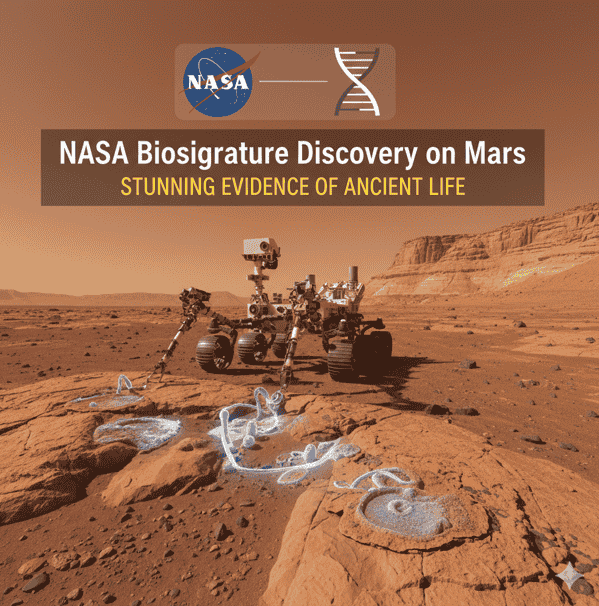NASA biosignature discovery on Mars by the Perseverance rover reveals potential signs of ancient microbial life in Jezero Crater, sparking global excitement.
Introduction: A Breakthrough in Space Exploration
On September 10, 2025, NASA biosignature discovery on Mars stunned the world with one of the most exciting discoveries in planetary science. The Perseverance rover detected convincing evidence of a potential biosignature—possible traces of past microbial life—within an ancient Martian riverbed. This announcement represents a historic milestone in humanity’s quest to answer the ultimate question: Are we alone in the universe?
The Moment of Discovery: Perseverance in Jezero Crater
The discovery was made in Jezero Crater, a vast impact basin on Mars that billions of years ago hosted a flowing river and a large lake. Perseverance, which landed here in February 2021, has been exploring this scientifically rich environment with one primary mission—to search for signs of ancient life and collect rock samples for eventual return to Earth.
In July 2024, the rover drilled into a rock formation near Cheyava Falls. The core sample, later nicknamed “Sapphire Canyon,” revealed stunning textures and chemical signatures. Scientists quickly realized that this humble piece of Martian mudstone might hold answers to questions humanity has been asking for generations.
What Did Perseverance Find?
This rock core is central to the NASA biosignature discovery on Mars caught attention for its unique “leopard spot” appearance—circular patterns and small nodules embedded in finely layered sediments. Using advanced instruments like PIXL (Planetary Instrument for X-ray Lithochemistry) and SHERLOC (Scanning Habitable Environments with Raman & Luminescence for Organics & Chemicals), Perseverance revealed remarkable findings:
- Minerals detected: vivianite and greigite, typically linked to oxygen-poor, water-rich environments on Earth where microbes thrive.
- Organic elements present: carbon, phosphorus, sulfur, and iron, arranged in repeating patterns.
- Chemical resemblance to Earth: these formations mirror the bio-geochemical processes driven by bacteria in ancient mud environments.
On Earth, such combinations often signal microbial activity—tiny life forms that shaped early ecosystems. While the Martian case isn’t confirmed, the similarities are striking.
What Is the NASA Biosignature Discovery on Mars?
NASA scientists have been cautious in their interpretation. The discovery is described as a “potential biosignature”—a feature that could have been produced by life but might also arise through non-biological processes.
To prevent overstatement, NASA applies the CoLD (Confidence of Life Detection) scale, which ranks findings from “unlikely” to “strong evidence of life.” Currently, the Jezero Crater discovery sits on the lower end of the scale, as abiotic explanations are still possible.
Still, many experts agree that this is the most promising evidence of ancient life on Mars to date. As lead researcher Joel Hurowitz notes, the context of the rock formation, coupled with the specific suite of minerals and compounds, makes this discovery particularly compelling.
Why Is This Discovery Important?
The NASA biosignature discovery on Mars highlights that Mars was once potentially habitable.
- If biological: It could confirm that Mars once hosted microbial ecosystems, proving life is not unique to Earth.
- If abiotic: It still teaches us how water, atmosphere, and geology interacted on the Red Planet for billions of years.
Either way, the discovery strengthens the case that Mars was once habitable, with the essential ingredients—water, energy, and carbon-based chemistry—to support life.
he Road Ahead After NASA Biosignature Discovery on Mars
Perseverance has now collected 27 rock cores, including the critical Sapphire Canyon sample. NASA plans to launch future missions to bring these samples back to Earth, where laboratories equipped with state-of-the-art instruments can analyze them with far greater precision than any rover could.
The discovery is also slated for publication in Nature, one of the world’s leading scientific journals. Importantly, NASA has released mission data publicly, ensuring that the global scientific community can test, debate, and expand upon the findings.
Humanity on the Threshold
This discovery is not just about rocks and chemistry—it’s about human curiosity, perseverance, and the universal quest for knowledge. Each core sample, each chemical analysis, brings us closer to solving the great cosmic mystery: Is life scattered across the universe, or did it bloom only on Earth?
As NASA Administrator Sean Duffy remarked, this is “the closest we have ever come to discovering life on Mars.” The coming years, with sample returns and further exploration, may finally reveal whether we share the cosmos with a second genesis of life.
Conclusion
NASA’s potential biosignature discovery on Mars marks a turning point in planetary science and astrobiology. Whether or not life is confirmed, this breakthrough opens the door to new questions, new missions, and new hope for future generations. Humanity stands on the edge of an extraordinary revelation—one that may forever change our understanding of life in the universe.
✅ Suggested External Links
- NASA’s Perseverance Mission Page
👉 https://mars.nasa.gov/mars2020/ - NASA Official News Release on Perseverance Discoveries
👉 https://www.nasa.gov/news - Nature Journal (where findings will be published)
👉 https://www.nature.com/ - European Space Agency – Life on Mars Research
👉 https://www.esa.int/Science_Exploration/Human_and_Robotic_Exploration/Exploration/Life_on_Mars - Scientific American – Life on Mars Articles
👉 https://www.scientificamerican.com/space/
